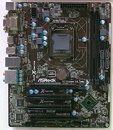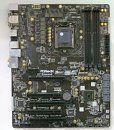- Joined
- Oct 9, 2007
- Messages
- 47,511 (7.49/day)
- Location
- Hyderabad, India
| System Name | RBMK-1000 |
|---|---|
| Processor | AMD Ryzen 7 5700G |
| Motherboard | ASUS ROG Strix B450-E Gaming |
| Cooling | DeepCool Gammax L240 V2 |
| Memory | 2x 8GB G.Skill Sniper X |
| Video Card(s) | Palit GeForce RTX 2080 SUPER GameRock |
| Storage | Western Digital Black NVMe 512GB |
| Display(s) | BenQ 1440p 60 Hz 27-inch |
| Case | Corsair Carbide 100R |
| Audio Device(s) | ASUS SupremeFX S1220A |
| Power Supply | Cooler Master MWE Gold 650W |
| Mouse | ASUS ROG Strix Impact |
| Keyboard | Gamdias Hermes E2 |
| Software | Windows 11 Pro |
Here is the first selection of ASRock socket LGA1150 motherboards, pictured at the 2013 CeBIT expo being held in Hanover, Germany. Intel's 4th generation Core "Haswell" desktop processor family introduces the new 1150-pin LGA socket and Intel 8-series chipset, to form the platform. An upgrade to to "Haswell" processors should hence also involve buying new motherboards. Top-two motherboard manufacturers ASUS and GIGABYTE reportedly lack booths at CeBIT, leaving only the rest to show off their LGA1150 goods. This first compilation includes boards by ASRock and BIOSTAR. The boards are also a little rough on the edges, as their component/PCB color schemes, heatsinks, etc., haven't been finalized.
ASRock unveiled two LGA1150 motherboard models, the entry-level B85M, and the high-end Z87-Extreme6 (pictured in that order). The B85M, based on the chipset that succeeds today's small business-optimized B75 chipset, is a compact micro-ATX motherboard. It features just the two DDR3 DIMM slots, an expansion area with a PCI-Express 3.0 x16, a PCI-Express 2.0 x16 (electrical x4), and two legacy PCI slots. Connectivity includes six SATA 6 Gb/s ports, 8-channel HD audio, four USB 3.0 ports, gigabit Ethernet; DVI, D-Sub, and HDMI display outputs, legacy connections such as COM/LPT over headers, and PS/2 mouse/keyboard connectors.


Moving on, the Z87-Extreme6 is much better equipped, and could lead ASRock's first wave of LGA1150 motherboards. It uses a 10-phase VRM to power the CPU, four DDR3 DIMM slots, three PCI-Express 3.0 x16 slots likely capable of x16/NC/NC or x8/x8/NC or x8/x4/x4; a PCI-Express 2.0 x1, an mPCIe, and two legacy PCI slots. The board features a total of eight internal SATA 6 Gb/s ports (six from the Z87 chipset, two by a third-party controller); and four USB 3.0 ports. Connectivity appears to include 8-channel HD audio, gigabit Ethernet, DVI, HDMI, and D-Sub display outputs. It's interesting to note on both ASRock boards that the PCH silicon appears smaller than what we're used to seeing on older 7-series chipset. Perhaps Intel finally got around to building PCH silicon on smaller silicon fab processes, such as 32 nm.
View at TechPowerUp Main Site
ASRock unveiled two LGA1150 motherboard models, the entry-level B85M, and the high-end Z87-Extreme6 (pictured in that order). The B85M, based on the chipset that succeeds today's small business-optimized B75 chipset, is a compact micro-ATX motherboard. It features just the two DDR3 DIMM slots, an expansion area with a PCI-Express 3.0 x16, a PCI-Express 2.0 x16 (electrical x4), and two legacy PCI slots. Connectivity includes six SATA 6 Gb/s ports, 8-channel HD audio, four USB 3.0 ports, gigabit Ethernet; DVI, D-Sub, and HDMI display outputs, legacy connections such as COM/LPT over headers, and PS/2 mouse/keyboard connectors.


Moving on, the Z87-Extreme6 is much better equipped, and could lead ASRock's first wave of LGA1150 motherboards. It uses a 10-phase VRM to power the CPU, four DDR3 DIMM slots, three PCI-Express 3.0 x16 slots likely capable of x16/NC/NC or x8/x8/NC or x8/x4/x4; a PCI-Express 2.0 x1, an mPCIe, and two legacy PCI slots. The board features a total of eight internal SATA 6 Gb/s ports (six from the Z87 chipset, two by a third-party controller); and four USB 3.0 ports. Connectivity appears to include 8-channel HD audio, gigabit Ethernet, DVI, HDMI, and D-Sub display outputs. It's interesting to note on both ASRock boards that the PCH silicon appears smaller than what we're used to seeing on older 7-series chipset. Perhaps Intel finally got around to building PCH silicon on smaller silicon fab processes, such as 32 nm.
View at TechPowerUp Main Site
Last edited:





